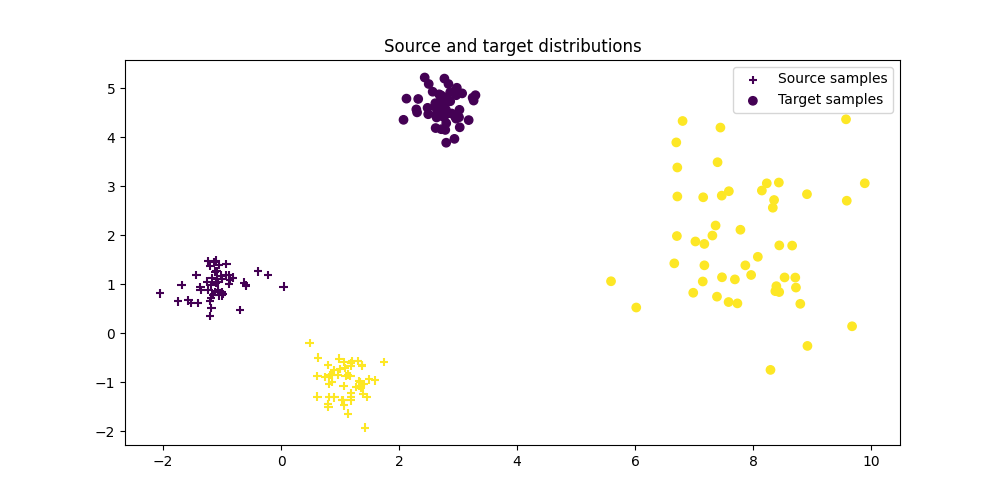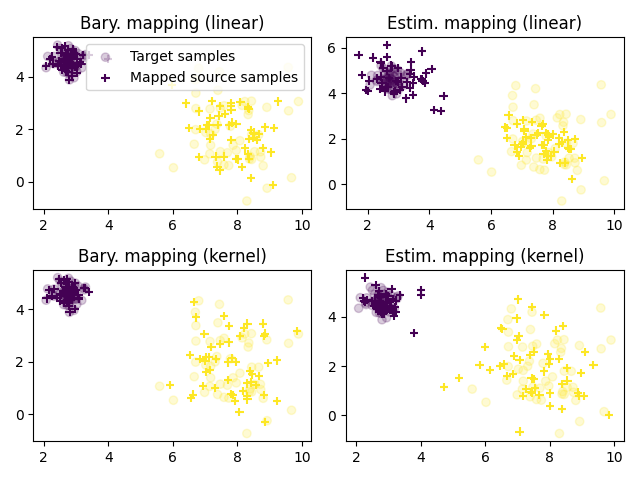Note
Go to the end to download the full example code.
OT mapping estimation for domain adaptation
Note
Example added in release: 0.1.9.
This example presents how to use MappingTransport to estimate at the same time both the coupling transport and approximate the transport map with either a linear or a kernelized mapping as introduced in [8].
[8] M. Perrot, N. Courty, R. Flamary, A. Habrard, “Mapping estimation for discrete optimal transport”, Neural Information Processing Systems (NIPS), 2016.
# Authors: Remi Flamary <remi.flamary@unice.fr>
# Stanislas Chambon <stan.chambon@gmail.com>
#
# License: MIT License
# sphinx_gallery_thumbnail_number = 2
import numpy as np
import matplotlib.pylab as pl
import ot
Generate data
n_source_samples = 100
n_target_samples = 100
theta = 2 * np.pi / 20
noise_level = 0.1
Xs, ys = ot.datasets.make_data_classif("gaussrot", n_source_samples, nz=noise_level)
Xs_new, _ = ot.datasets.make_data_classif("gaussrot", n_source_samples, nz=noise_level)
Xt, yt = ot.datasets.make_data_classif(
"gaussrot", n_target_samples, theta=theta, nz=noise_level
)
# one of the target mode changes its variance (no linear mapping)
Xt[yt == 2] *= 3
Xt = Xt + 4
Plot data

Text(0.5, 1.0, 'Source and target distributions')
Instantiate the different transport algorithms and fit them
# MappingTransport with linear kernel
ot_mapping_linear = ot.da.MappingTransport(
kernel="linear", mu=1e0, eta=1e-8, bias=True, max_iter=20, verbose=True
)
ot_mapping_linear.fit(Xs=Xs, Xt=Xt)
# for original source samples, transform applies barycentric mapping
transp_Xs_linear = ot_mapping_linear.transform(Xs=Xs)
# for out of source samples, transform applies the linear mapping
transp_Xs_linear_new = ot_mapping_linear.transform(Xs=Xs_new)
# MappingTransport with gaussian kernel
ot_mapping_gaussian = ot.da.MappingTransport(
kernel="gaussian", eta=1e-5, mu=1e-1, bias=True, sigma=1, max_iter=10, verbose=True
)
ot_mapping_gaussian.fit(Xs=Xs, Xt=Xt)
# for original source samples, transform applies barycentric mapping
transp_Xs_gaussian = ot_mapping_gaussian.transform(Xs=Xs)
# for out of source samples, transform applies the gaussian mapping
transp_Xs_gaussian_new = ot_mapping_gaussian.transform(Xs=Xs_new)
It. |Loss |Delta loss
--------------------------------
0|4.190105e+03|0.000000e+00
1|4.170411e+03|-4.700201e-03
2|4.169845e+03|-1.356805e-04
3|4.169664e+03|-4.344581e-05
4|4.169558e+03|-2.549048e-05
5|4.169490e+03|-1.619901e-05
6|4.169453e+03|-8.982881e-06
It. |Loss |Delta loss
--------------------------------
0|4.207356e+02|0.000000e+00
1|4.153604e+02|-1.277552e-02
2|4.150590e+02|-7.257432e-04
3|4.149197e+02|-3.356453e-04
4|4.148198e+02|-2.408251e-04
5|4.147508e+02|-1.661834e-04
6|4.147001e+02|-1.223502e-04
7|4.146607e+02|-9.506358e-05
8|4.146269e+02|-8.141766e-05
9|4.145989e+02|-6.750100e-05
10|4.145770e+02|-5.283163e-05
Plot transported samples
pl.figure(2)
pl.clf()
pl.subplot(2, 2, 1)
pl.scatter(Xt[:, 0], Xt[:, 1], c=yt, marker="o", label="Target samples", alpha=0.2)
pl.scatter(
transp_Xs_linear[:, 0],
transp_Xs_linear[:, 1],
c=ys,
marker="+",
label="Mapped source samples",
)
pl.title("Bary. mapping (linear)")
pl.legend(loc=0)
pl.subplot(2, 2, 2)
pl.scatter(Xt[:, 0], Xt[:, 1], c=yt, marker="o", label="Target samples", alpha=0.2)
pl.scatter(
transp_Xs_linear_new[:, 0],
transp_Xs_linear_new[:, 1],
c=ys,
marker="+",
label="Learned mapping",
)
pl.title("Estim. mapping (linear)")
pl.subplot(2, 2, 3)
pl.scatter(Xt[:, 0], Xt[:, 1], c=yt, marker="o", label="Target samples", alpha=0.2)
pl.scatter(
transp_Xs_gaussian[:, 0],
transp_Xs_gaussian[:, 1],
c=ys,
marker="+",
label="barycentric mapping",
)
pl.title("Bary. mapping (kernel)")
pl.subplot(2, 2, 4)
pl.scatter(Xt[:, 0], Xt[:, 1], c=yt, marker="o", label="Target samples", alpha=0.2)
pl.scatter(
transp_Xs_gaussian_new[:, 0],
transp_Xs_gaussian_new[:, 1],
c=ys,
marker="+",
label="Learned mapping",
)
pl.title("Estim. mapping (kernel)")
pl.tight_layout()
pl.show()

Total running time of the script: (0 minutes 0.875 seconds)